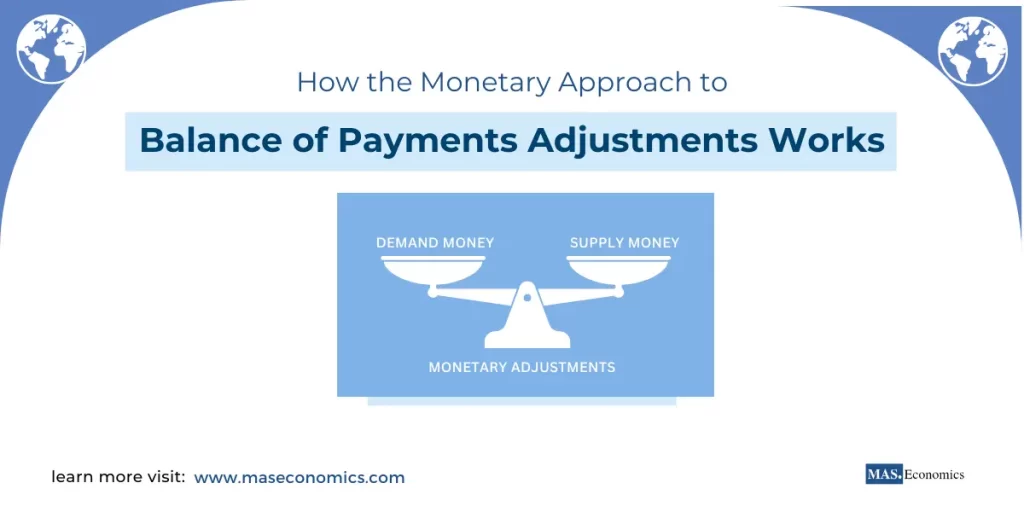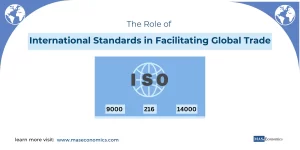The Balance of Payments (BOP) is a key indicator of a country’s economic standing with the rest of the world. Any imbalance—whether a deficit or a surplus—requires adjustments to restore equilibrium. One effective approach to addressing BOP imbalances is the Monetary Approach. Unlike traditional methods that focus on trade and financial transactions, the monetary approach emphasizes the role of money supply, interest rates, and overall monetary policy in influencing the balance of payments.
The monetary approach to Balance of Payments adjustments highlights how monetary policies and changes in money supply affect equilibrium, along with the impact of interest rates and currency valuation. Understanding this approach reveals how monetary policy can serve as a powerful tool for maintaining international financial stability.
What is the Monetary Approach to Balance of Payments?
The Monetary Approach to BOP Adjustments suggests that BOP disequilibrium—whether surplus or deficit—is fundamentally a monetary phenomenon. This means that any imbalance in the balance of payments arises from a discrepancy between the supply of money and the demand for money within the country.
Core Principle
The fundamental idea is that a BOP deficit occurs when the money supply exceeds the demand for money, leading to excessive spending on imports and foreign investments. Conversely, a BOP surplus occurs when the demand for money exceeds its supply, resulting in a buildup of foreign exchange reserves as international transactions bring more funds into the country.
This approach is based on the belief that BOP imbalances are temporary and will eventually self-correct as monetary conditions adjust. For example, a reduction in foreign reserves in response to a BOP deficit will lead to a decrease in the domestic money supply, which in turn will reduce demand for imports, help restore BOP equilibrium, and ultimately balance the international accounts.
Components of the Monetary Approach to BOP Adjustment
The monetary approach involves several key components that determine how the money market interacts with international accounts to correct imbalances.
Demand and Supply of Money
According to the monetary approach, the BOP imbalance can be expressed using a simple equation:
\( B = M_d – M_s \)
Where:
- \( B \) represents the Balance of Payments.
- \( M_d \) represents the demand for money.
- \( M_s \) represents the supply of money.
In this equation, the balance of payments is determined by the difference between money demand and money supply. If money demand exceeds the supply (\( M_d > M_s \)), the result is a BOP surplus. Conversely, if money supply exceeds demand (\( M_s > M_d \)), a BOP deficit occurs.
The Role of Foreign Exchange Reserves
In the monetary approach, foreign exchange reserves play a critical role in the self-correcting mechanism of the balance of payments. A BOP deficit leads to a reduction in foreign exchange reserves, which ultimately decreases the money supply. This decline in the money supply has several effects:
Decrease in Domestic Prices: As the money supply shrinks, domestic demand drops, causing prices to fall.
Increased Exports: Lower domestic prices make a country’s goods more competitive on the international market, which boosts exports.
Reduced Imports: The reduced purchasing power results in fewer imports, thus narrowing the trade gap.
Similarly, in the case of a BOP surplus, increased foreign exchange reserves lead to an increase in the domestic money supply. This causes prices to rise, increasing imports and reducing exports, eventually eliminating the surplus.
How Interest Rates Influence BOP Adjustments
Interest rates are one of the most powerful tools of monetary policy and play a pivotal role in the monetary approach to BOP adjustments. Let’s explore how changes in interest rates affect the balance of payments.
Interest Rate Adjustments and Capital Flows
Interest rates affect the movement of capital between countries. Higher interest rates attract foreign investment, leading to capital inflows, while lower rates may result in capital outflows. These flows directly influence the BOP:
Higher Interest Rates: When a country raises its interest rates, it becomes more attractive to foreign investors looking for better returns. This results in an inflow of foreign funds, which improves the financial account of the BOP.
Lower Interest Rates: Conversely, if a country reduces its interest rates, capital may flow out in search of better returns elsewhere, worsening the BOP. This outflow will also reduce foreign reserves, impacting the overall money supply.
Relationship Between Money Supply and Interest Rates
Changes in the money supply can also impact interest rates. For instance, a decrease in money supply due to a BOP deficit can drive up interest rates, which then makes saving more attractive, reduces spending, and encourages more foreign investments. This helps to restore BOP equilibrium.
Conversely, an increase in money supply from a BOP surplus can lead to a fall in interest rates, reducing foreign investment and encouraging domestic spending, which ultimately works to correct the surplus.
Self-Correcting Mechanism of the Monetary Approach
The self-correcting mechanism is at the core of the monetary approach, emphasizing that imbalances in the BOP are temporary and can adjust naturally through changes in monetary variables.
Example of Self-Correction: BOP Deficit
Consider a country experiencing a BOP deficit:
Foreign Reserves Decrease: The deficit results in a reduction of foreign reserves.
Money Supply Shrinks: The decline in foreign reserves leads to a decrease in the domestic money supply.
Domestic Prices Drop: With a reduced money supply, overall spending declines, which brings down domestic prices.
Exports Increase: Lower prices make domestic goods cheaper in international markets, leading to an increase in exports.
Imports Decline: At the same time, the purchasing power of residents falls, leading to fewer imports.
This sequence of events gradually corrects the deficit and helps the country move back towards BOP equilibrium.
Example of Self-Correction: BOP Surplus
In the case of a BOP surplus:
Foreign Reserves Increase: The surplus leads to an increase in foreign reserves.
Money Supply Increases: The growing reserves expand the domestic money supply.
Domestic Prices Rise: With more money in circulation, demand increases, pushing domestic prices up.
Exports Decline: Higher prices make domestic goods less competitive internationally, leading to a reduction in exports.
Imports Increase: Meanwhile, increased purchasing power results in higher demand for foreign goods, leading to an increase in imports.
This process automatically reduces the surplus and moves the BOP toward equilibrium.
The Role of Currency Valuation in BOP Adjustments
Currency valuation is another important factor in the monetary approach to balance of payments adjustments. The value of a country’s currency directly affects both the trade balance and capital flows.
Devaluation and BOP Correction
A country facing a BOP deficit may choose to devalue its currency. Devaluation makes exports cheaper for foreign buyers and imports more expensive for domestic consumers, which helps:
- Boost Exports: Cheaper exports become more competitive, increasing foreign sales.
- Reduce Imports: More expensive imports reduce demand, which helps narrow the BOP deficit.
Revaluation and Managing BOP Surplus
On the other hand, a country with a persistent BOP surplus may revalue its currency. This action will make exports more expensive and imports cheaper, thus:
- Reduce Export Competitiveness: Higher export prices make them less attractive, thereby reducing the surplus.
- Encourage Imports: Cheaper imports boost demand for foreign goods, helping to balance the payments.
Conclusion
The monetary approach to balance of payments adjustments offers a framework for understanding how monetary policy, money supply, and interest rates interact to correct BOP imbalances. Adjustments in money supply, foreign reserves, interest rates, and currency valuation all play roles in restoring equilibrium.
This approach emphasizes the importance of monetary authorities in managing a country’s economic relations globally. By adjusting money supply, interest rates, and currency valuation, central banks can navigate global economic complexities and maintain financial stability.
What is the monetary approach to Balance of Payments (BOP)?
The monetary approach explains BOP imbalances as a result of discrepancies between a country’s money supply and demand. A surplus occurs when money demand exceeds supply, while a deficit arises when supply exceeds demand.
How does the monetary approach address BOP deficits or surpluses?
It highlights self-correcting mechanisms where deficits reduce foreign reserves and money supply, lowering imports and increasing exports. Conversely, surpluses increase reserves and money supply, raising imports and reducing exports.
What role do foreign exchange reserves play in the monetary approach?
Foreign exchange reserves act as a balancing tool. A deficit reduces reserves, shrinking the money supply and curbing spending, while a surplus increases reserves, expanding the money supply and boosting imports.
How do interest rates influence the balance of payments?
Higher interest rates attract foreign capital, improving the BOP by increasing inflows. Lower rates can lead to capital outflows, worsening the BOP. Adjusting interest rates helps regulate these flows.
How does currency valuation affect BOP adjustments?
Devaluing the currency helps correct deficits by making exports cheaper and imports costlier. Revaluation is used to manage surpluses by making exports more expensive and encouraging imports.
What is the self-correcting mechanism in the monetary approach?
Imbalances in the BOP adjust naturally as changes in foreign reserves influence the domestic money supply, which affects prices, imports, and exports, restoring equilibrium over time.
Why is the monetary approach significant for policymakers?
It provides a framework to manage BOP imbalances by adjusting monetary policies, such as money supply, interest rates, and currency values, ensuring financial stability and sustainable trade balances.
Thanks for reading! Share this with friends and spread the knowledge if you found it helpful.
Happy learning with MASEconomics




